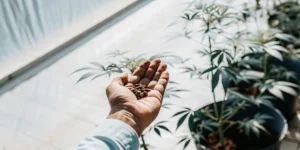Many people often discuss the difference between drunk and high, especially when considering their evening plans. Alcohol intoxication vs marijuana high offers two distinct experiences. While both can alter your state of mind, they do so in unique ways. Exploring these differences can help you make informed choices.
The effects of being drunk versus high can depend on several factors, including your body’s tolerance, the quantity consumed, and even your environment. A night out with friends might feel different when you’re drinking compared to when you’re enjoying a cannabis strain like the versatile Blue Dream. Understanding these nuances is crucial for both novice and experienced users.
When comparing drunk and high experiences, it’s essential to consider the physical symptoms. Alcohol tends to slow down your reactions, affecting coordination and speech. On the other hand, marijuana might make you feel relaxed or even euphoric, with some strains like OG Kush offering a mellow high. Each experience is different, and knowing what to expect can enhance your enjoyment.
Physical Symptoms of Drunk Versus High
Alcohol intoxication can bring about noticeable physical changes. These might include slurred speech, impaired coordination, and even nausea. It’s why you might find it hard to walk in a straight line after a few drinks. These symptoms are often used to gauge how drunk someone is.
In contrast, the physical symptoms of a marijuana high might include red eyes, dry mouth, and increased appetite, often referred to as “the munchies.” Strains like White Widow are known for producing these effects. While these symptoms are generally less severe than those from alcohol, they are still important to recognize.
Another difference between drunk and high is the level of physical impairment. While alcohol often leads to a lack of coordination and balance, cannabis tends to have a less pronounced impact on motor skills. However, it’s still crucial to avoid activities that require full alertness and coordination, no matter the substance.
The effects of being drunk versus high can also be influenced by individual factors such as metabolism and genetic predispositions. Some people might experience more severe symptoms with alcohol, while others may feel heightened effects from cannabis. Understanding your body’s unique responses can be beneficial in managing your experiences.
Mental Effects: How Does Being Drunk Differ from Being High?
The mental effects of alcohol can range from feeling relaxed and sociable to experiencing mood swings or aggression. These shifts are due to alcohol’s depressant properties, which can lower inhibitions and impact decision-making.
On the other hand, a marijuana high usually results in a more relaxed state. However, it can also enhance creativity and induce laughter. Depending on the strain, like the energetic Blue Dream, users might find themselves more focused or introspective.
When considering how does being drunk differ from being high, it’s important to note the impact on memory and cognition. Alcohol is known to impair short-term memory, often leading to forgetfulness during intoxication. Marijuana, while affecting memory differently, can sometimes enhance focus or lead to deep introspection, varying widely among users.
Moreover, comparing drunk and tipsy experiences reveals a difference in emotional processing. Alcohol might amplify emotions, leading to heightened aggression or sadness, whereas cannabis often induces a state of calm or euphoria. Knowing these mental effects can guide your choice depending on the mood you seek to achieve.

Social Experiences: Comparing Drunk and High Experiences
Social gatherings can feel quite different depending on whether you’re drunk or high. Drinking alcohol can lead to louder, more boisterous interactions. It’s common to see groups of friends laughing loudly or engaging in deep conversations after a few drinks.
Conversely, when using cannabis, social experiences might be more relaxed. People often report feeling connected and at ease with others. Strains like OG Kush can offer a calming effect, making social interactions smooth and enjoyable.
In analyzing the difference between drunk and high in social settings, one might observe that alcohol tends to encourage extroversion, often leading to uninhibited social behavior. Cannabis, however, may allow for more contemplative interactions, where conversations can become more meaningful and introspective.
Comparing drunk and high experiences also involves understanding the social dynamics at play. While alcohol might spark spontaneous social activities, cannabis can foster a more laid-back environment where connections are formed over shared experiences and relaxed discussions.
Health Impacts: Long-Term Differences
Regular alcohol consumption can lead to significant health issues, such as liver damage or addiction. It’s crucial to be aware of these risks when choosing to drink frequently. Moderation is key to minimizing potential harm.
Marijuana, meanwhile, carries its own set of health considerations. While it’s generally seen as less harmful than alcohol, excessive use can lead to dependency or impact lung health if smoked. Choosing strains like White Widow and using them responsibly can help mitigate these risks.
The difference between drunk and high extends to their long-term health impacts. Alcohol’s potential for addiction and organ damage is well-documented, making it vital to approach consumption with caution. Conversely, while marijuana is perceived as less addictive, chronic use can still affect mental health and cognitive functions.
Knowing the effects of being drunk versus high over time can guide healthier lifestyle choices. Both substances demand a balanced approach, with awareness of their potential risks guiding responsible use to ensure overall well-being.

FAQs
What are the legal implications of being drunk versus high?
Legal implications can vary significantly between alcohol and marijuana. Alcohol is legal for adults over 21 in the U.S., but driving under the influence can lead to severe penalties, including fines and jail time. Public intoxication is another legal issue to be mindful of.
Marijuana laws differ by state. While some states have legalized recreational use, others have not. It’s important to know the laws in your area to avoid legal trouble. Remember, driving high is also illegal and carries similar penalties to drunk driving.
Comparing drunk and high experiences legally involves understanding the complexities of regulation. While alcohol has been legal longer and is more widely accepted, marijuana laws are evolving. Staying informed about these changes is crucial for responsible consumption.
The difference between drunk and high from a legal standpoint highlights the necessity of awareness. Whether it’s knowing the permissible limits of alcohol or understanding state-specific cannabis laws, being informed helps avoid legal repercussions and promotes responsible use.
Can you mix alcohol and cannabis safely?
Mixing alcohol and cannabis is generally not recommended due to the unpredictable effects. The combination can amplify impairment, leading to increased risks of accidents or negative health impacts.
Some people experience dizziness or nausea when combining the two. If you choose to mix, start with small amounts to gauge your body’s reaction. Always prioritize safety and be aware of your limits.
Exploring how does being drunk differ from being high becomes even more complex when both are combined. The interactions between alcohol and cannabis can vary greatly, with some users experiencing heightened impairment or discomfort.
Understanding the effects of being drunk versus high separately is crucial before considering mixing them. Each substance affects the body uniquely, and their combination can lead to unexpected outcomes, reinforcing the importance of cautious and informed use.
How do different strains of cannabis affect the high experience?
Different cannabis strains can significantly alter the high experience. Indica strains like OG Kush tend to produce relaxing, sedative effects, making them ideal for evening use.
Sativa strains, such as Blue Dream, are known for their uplifting and energetic effects, perfect for daytime activities. Hybrid strains offer a mix of both, providing a balanced experience.
When comparing drunk and high experiences, the choice of cannabis strain plays a pivotal role in shaping the high. While alcohol generally provides a consistent effect, cannabis can offer a wide array of experiences, from relaxation to stimulation, depending on the strain.
Understanding the effects of being drunk versus high also involves exploring how different strains impact your mood and energy levels. Selecting the right strain can enhance your experience, aligning it with your personal preferences and desired outcomes.
What should I do if I feel uncomfortable while drunk or high?
If you feel uncomfortable while drunk, the best course of action is to stop drinking and hydrate. Find a safe space to rest and seek help from friends if needed. Remember, it’s okay to ask for assistance when feeling overwhelmed.
If you’re feeling uncomfortable while high, try to stay calm and remind yourself that the effects will pass. Drinking water, eating a snack, or changing your environment can help. If anxiety persists, reach out to someone you trust for support.
Understanding the difference between drunk and high can prepare you for managing discomfort effectively. Each experience comes with its own set of challenges, and knowing how to address them can contribute to a safer and more enjoyable time.
Comparing drunk and high experiences also involves recognizing when to seek help. Whether it’s dealing with the physical symptoms of drunk versus high or managing emotional turmoil, having a plan for support can make all the difference in handling adverse effects.
Which is more socially acceptable, being drunk or high?
Social acceptance of being drunk versus high varies by region and social circles. In many places, alcohol use is more normalized due to its long-standing cultural presence. Public events and gatherings often include alcohol.
However, as legalization spreads, marijuana use is becoming more accepted. Social norms are shifting, and cannabis is increasingly seen as a viable alternative for relaxation and enjoyment. Personal and cultural attitudes will heavily influence acceptance.
Exploring the difference between drunk and high in terms of social acceptance reveals evolving perceptions. While alcohol remains a staple in many social settings, cannabis is gaining ground, particularly among younger demographics who view it as a healthier alternative.
Ultimately, how does being drunk differ from being high socially hinges on cultural context and individual beliefs. As societal attitudes continue to shift, both substances are finding their place in social interactions, allowing individuals to choose based on personal comfort and acceptance levels.





